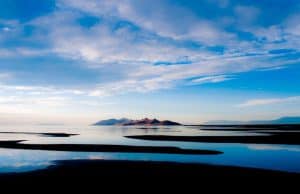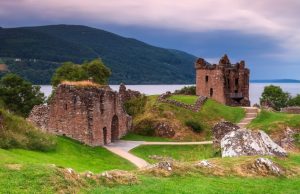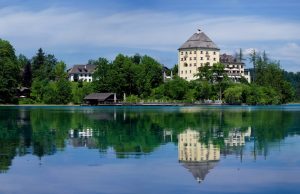This post contains affiliate links. If you click and purchase, we may earn a small referral fee at no extra cost to you. Read our full disclosure.
Most of us have witnessed the cinematic re-creation of the world’s most famous shipwreck. The 1997 box office smash “Titanic” earned 11 Oscar Awards. Although shipwrecks conjure up images of ships sinking in open seas or running aground on dangerous shoals, lakes have claimed their share of shipwrecks.
According to NOAA, the National Oceanic and Atmospheric Administration, the Great Lakes alone have claimed more than 12,000 boats and ships! This post explores famous and not-so-famous lakes around the world with shipwrecks and sunken boats, steamboats, and barges.
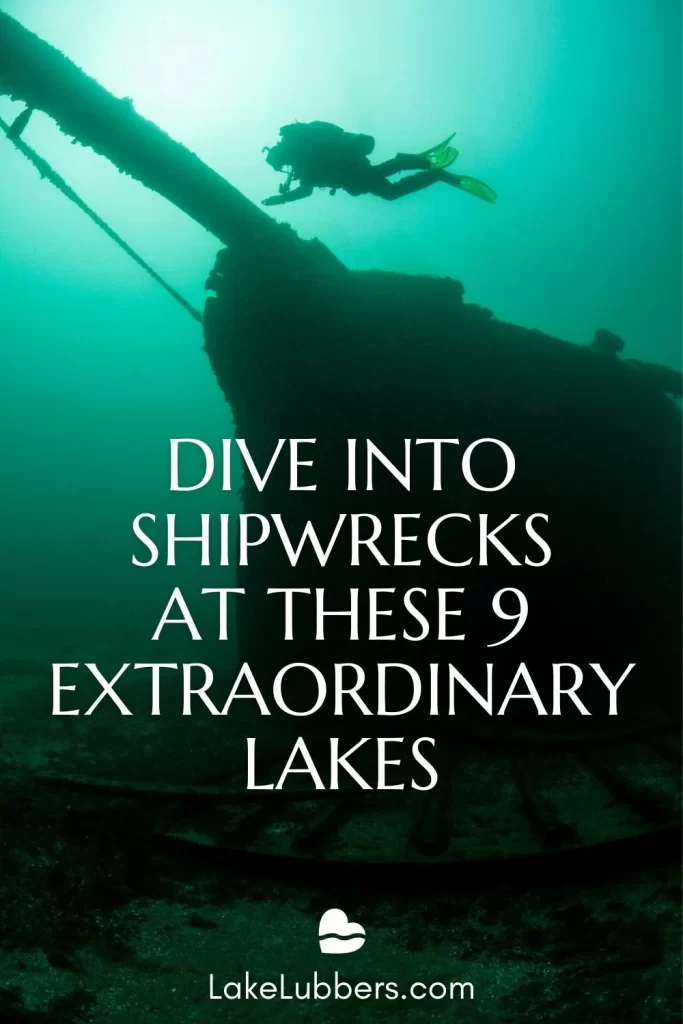
1 – Lake Huron
A glacial lake of epic proportions, Lake Huron covers more than 14,700,000 acres, and borders Michigan in the USA and Ontario in Canada.
Steeped in maritime history, the Thunder Bay National Marine Sanctuary, operated by NOAA, protects over 200 shipwrecks in Lake Huron. Located in Thunder Bay near Alpena, Michigan, the Sanctuary’s collection highlights the diversity of ships that navigated the Great Lakes in the 19th and 20th centuries.
Get immersed in the lore of the Great Lakes maritime history during your Lake Huron vacation.

2 – Lake Superior
Skipping over state and country borders, Lake Superior reigns as the largest freshwater lake in the world by surface area. This Great Lake spans more than 20,000,000 acres, bordering Michigan, Minnesota, Wisconsin, and Ontario.
The Great Lakes Shipwrecks Historical Society is located on Michigan’s Upper Peninsula at the Whitefish Point Light Station, a National Historic Site. The Society explores well-preserved shipwrecks from the past 100 years.
Also located on Michigan’s Upper Peninsula is the Alger Underwater Preserve. Scuba divers at all skill levels can explore underwater caves, complete shipwrecks, underwater interpretive trails, and an underwater museum.
The Michigan town of Munising is centrally located to Grand Island, a National Recreation Area, and to Pictured Rocks National Lakeshore. Plan your Lake Superior vacation.

3 – Portage Lake, Michigan
Connected to Lake Michigan by a channel, 2,110-acre Portage Lake served as a port to Lake Michigan during the age of steamships.
Resorts and lavish homes were built along the shore during the steamship era. The resorts did a flourishing business during Prohibition when high-grade alcohol was smuggled in from Canada on schooners.
Today, shipwrecks lay at the bottom of Portage Lake. The Music, a pleasure steamer that offered moonlight concert tours, caught fire and was set adrift. A report from that era reminisces that the Music made a glorious sight, floating off into the darkness engulfed in flames.
Portage Lake is now a popular recreation lake, with sailboats, fishing boats, and other pleasure craft plying the waters. In winter, ice fishing, ice boating, and other winter sports take center stage.

4 – Diamond Lake, Michigan
For those who dream of living on a private island, Diamond Lake in southwest Michigan can turn dreams into reality.
Diamond Lake, with Diamond Island in the middle, offers 1,020 acres of water recreation with residential development tucked along the wooded shoreline of both. A private barge provides transportation to Diamond Island.
Diamond Lake is an all-sports lake whether your pleasure is a canoe, kayak, sailboat, or motor boat. A favorite dive site was the 60-foot steamboat South Bend, about 40 feet beneath the surface. In 1989, resident divers reconstructed the shipwreck underwater, and now a buoy with the words “Ship Wreck” marks the area. Plan your visit to Diamond Lake.

5 – Lake Crescent, Washington
Lake Crescent is a majestic glacial lake located at the northern tip of the Olympic National Forest in Washington state.
The lake is serenely scenic, nestled at the base of Mount Storm King, an imposing 4,534 peak located on the south side of the lake. Known for its pristine turquoise water, 5,127-acre Lake Crescent reaches depths of 624 feet, with the bottom of the lake reaching below sea level.
Two unique trout species, the Beardslee trout and, make their home in Lake Crescent. Recreation reigns supreme both on top of the water and below.
Scuba diving is popular due to the extremely clear water, unusually deep light penetration, and lack of current. Divers will find a sunken wooden barge, a dory-style boat wreck, car wrecks, an underwater rock garden, and an underwater forest where they can swim through trees located 60 feet below the lake’s surface.
Lake Crescent is popular for fishing, boating, kayaking, canoeing, hiking, bird watching, and camping.

6 – Lake George, New York
Sitting pretty at the base of New York’s majestic Adirondack Mountains, Lake George’s nickname is “Queen of American Lakes.”
The 28,000-acre glacial lake is dotted with islands and notable rock formations. It is surrounded by beautiful mountains and scenic vistas. Though its history is rich, today the lake serves as a recreational playground for area residents and tourists from all over the world. Scuba diving is superb here due to the clarity of the water.
Two documentaries have explored shipwrecks from the French and Indian War, known as “The Sunken Fleet of 1758.” With winter approaching and no fort to protect the fleet, British forces deliberately sank 260 of their warships (25-35 foot long boats known as “bateaux”), intending to raise them the following year after the ice melted.
However, many of the sunken vessels were not retrieved, and have become subjects in the study of underwater archeology.
Today, an underwater state park allows scuba divers to “Dive Into History.” Thomas Jefferson wrote that “Lake George is without comparison, the most beautiful water I ever saw.”

7 – Kootenay Lake, British Columbia
Kootenay means “water people,” a term that applies to the lake today. Covering more than 96,000 acres, there is more than enough room for canoes, kayaks, power boats, sailboats, and houseboats.
Surrounded by the Selkirk and Purcell Mountain ranges, Kootenay Lake reflects the icy peaks of Kokanee Glacier. The lake is well-known for its Gerrard Rainbow, the world’s largest trout.
Sternwheelers (paddle steamers) were used to transport materials for the railroad and passengers from the late 1800s through the 1950s, because they could carry heavy loads and operate in shallow water.
The SS Moyie is the world’s oldest intact passenger sternwheeler. Serving on Kootenay Lake for more than 60 years, it has been restored and is now part of a museum.
However, other sternwheelers now lie on the bottom of Kootenay Lake. The underwater world of shipwrecks, sunken railroad cars, and sunken mining equipment are popular attractions for scuba divers. Several provincial parks ring the lake, offering beaches for swimming, trails for hiking and cross-country skiing, rock climbing, and camping.

8 – Lake Laberge, Yukon, Canada
Nestled in the Yukon wilderness of Canada, Lake Laberge covers almost 50,000 acres with depths reaching almost 480 feet. Jutting mountain peaks surround miles of beaches and its many bays.
Yukon is a semi-arid, pristine wilderness in northwestern Canada. Lake trout and whitefish populate the lake. Because a hydroelectric dam built in 1956 disrupted the spawning cycle of the Chinook salmon, the power company built the Whitehorse Fishway, which has the longest wooden fish ladder in the world. An interpretation center at the Fishway has an underwater window where visitors can watch salmon on their spawning journey.
Sunken treasures lay beneath the icy waters of Lake Laberge, including the perfectly preserved Gold Rush steamer, the A.J. Goddard, that sank over 100 years ago.
The dazzling Northern Lights (aurora borealis) light up the lake, usually from December through March, when winter sports (dog sledding, cross-country skiing, snowshoeing) take center stage.

9 – Lake Tenkiller, Oklahoma
Tucked away into the foothills of the Ozark Mountains is Lake Tenkiller, a 12,900-acre reservoir created by the U.S. Army Corps of Engineers in 1953 for flood control and hydropower. The name Tenkiller may have originated from a Cherokee warrior who had ten notches on his bow.
Lake Tenkiller is a popular destination for all types of water recreation such as boating, fishing, swimming, water skiing, wakeboarding, and sailing. But what lurks below the water’s surface is just as interesting as sights above.
The lake is a scuba diver’s haven due to the clarity and depth of the water. An underwater scuba park features sunken boats, vehicles, and airplanes. A town was flooded when the lake was created, leaving behind structures and artifacts such as houses, buggies, wagon wheels, and a jailhouse.
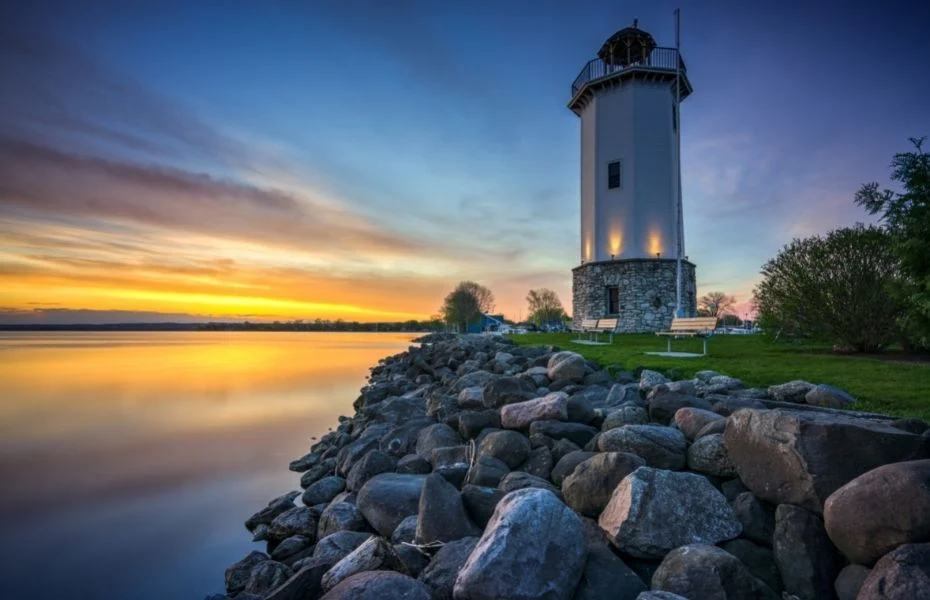
Lake Lighthouses: Beautiful Beacons Steeped in History
Lighthouses evoke images of beacons warning passing ships of dangerous ocean shoals. But lighthouses are not the exclusive domain of ocean coastlines. These maritime lifesavers have a long history of guarding the Great…

